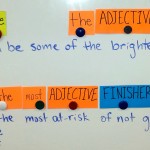We were asked to introduce ourselves in our blogs this week, and that feels funny, since this is the sixth (or seventh?) year I have had the opportunity to contribute to Stories from School Arizona. This will be my 25th year teaching English in Arizona, and I have found that as my positions and expertise change and grow, my passions and causes shift. One thing has been consistent: As a teacher, there is always a worthy cause to champion in the name of supporting students, teachers and families. This reality renews my commitment to teaching each year, and my appreciation for the opportunity to write about how policies shape my classroom practice and the experiences of students and teachers. There is always a challenge, a call to action, or a catalyst for thought or innovation.
Over the past two legislative sessions, as Arizona grappled with the future of the notorious “four-hour block” of language instruction for English learners, I thought and wrote a lot about equity and how both state policy and local structures impact equity for students learning English.
As this year begins, I am hopeful that we at our junior high school (and at the state level) are taking steps that lead toward greater equity for the English learners in our language acquisition program. In the spring, the state ultimately eliminated the four-hour block and modified ELD requirements, opening up many possibilities for how to structure a program to help students acquire English, pass AZELLA and be successful outside the ELD class. News outlets showed great interest in what could be the impact in ELD classrooms across the state with the policy changes.
Our school, after our first full year of Rhodes to Success, was able to make a commitment to increased staffing in ELD, which allowed us to split the 7th and 8th graders and incorporate our ELD students fully into the teams within our school. In our school, teaming is the circulatory system, and the students our life’s blood. With very few exceptions, teams determine daily schedules and the nitty gritty of which students are getting which classes or services when. Every team member helps determine the flow of students through the day and what “nutrients” they are receiving throughout. I am trying to think of what would have represented that circulatory system when our school was more traditional. The bell schedule? Maybe. We don’t even have one of those now.
I have to say, it has been a huge relief to have a team! Now there is a whole community of teachers looking out for our English learners. It is easier to distribute information, share observations, brainstorm creative solutions to scheduling issues and innovate around building these students’ language skills as quickly as possible while engaging them in work that includes some pretty hefty academic demands. EL’s will have the opportunity to take music or art for at least one semester, something the introduction level students have not had for the five years I have been at this school. In addition, because we have an elective teacher embedded into our team, once the students complete the requirements of their computer basics class, they will be able to participate in woodworking projects throughout the year.
I co-teach an advisory class with another experienced teacher, which means that during this time I have the flexibility to meet with newcomers, help them get their binders put together, explain their schedule, pair them up with a buddy, give them a chance to figure out how to login to the computer, etc. (We are a 1:1 school, so they need to get on board quickly!) I can pull groups of students who have common needs, or visit other advisories where my ELD students are working independently on other classes’ work. In addition, each student will receive individual mentoring during this time from either me or someone else.
I am finding that teaming in this way is intense, and definitely eats into my individual planning time. It also involves an interminable parade of spreadsheets, and shared Google Drive folders within folders within folders. However, I can already see how having common expectations and procedures, common language around our academic work (through Summit learning platform), shared effort to communicate with families, and the opportunity to collaborate around individual students will create an environment where students can feel safe and seen, and thrive academically.
In order for these changes to have been implemented, our administration and leadership team has been collaborating for the past 8-10 months gathering lessons and insights from the experiences of the past two years. Administration has ensured that those conversations continued, and has maintained their commitment to our unique model for organizing our school and curriculum. Teachers have been provided with professional development, extra planning days and the autonomy within teams to address many issues and build flexible student schedules. More time than some teachers would prefer (haha!) has been devoted to team-building, but a circulatory system cannot work if the parts are disconnected from one another. When I think about the labor, risk-taking and commitments from our administration that have made our program possible, I am a bit in awe that Rhodes to Success has even happened within a public school district. I, for one, have never had the opportunity to be part of anything like this in secondary education in the past.
The changes my school has made are ongoing. Our program is still a work in progress. I think that to a degree, this will continue to be the case. The brilliance of the program is its flexibility and adaptability to change. It will continue to refine or reinvent itself as needed. As long as we have the resources to continue to fully staff our ELD program (and all the others!), I can’t help but believe that we will begin to see real results in the academic progress and sense of belonging all students experience at Rhodes and beyond.

This was part of a project we did based on Lowriders in Space, a graphic novel by Cathy Camper and Raul III. Definitely a story about teamwork and dreams!










Comments 1
“The brilliance of the program is its flexibility and adaptability to change.” I think this is one of the most important sentences I have read in regard to policies that impact students. Too many times, policies are rigid and strict. They are written in blacks and whites with little room for gray areas. There is no wiggle room or places to make exceptions. Our students do not thrive in those systems. Our students are fluid and different. What works for one, will not work for others. There are too many differences for our students to thrive in a one-size-fits-all model. Our instruction needs to be adaptable and flexible to meet their needs.